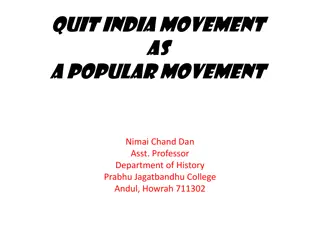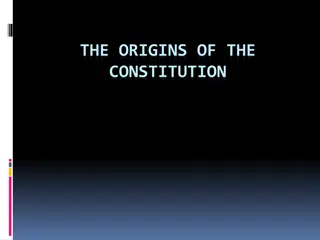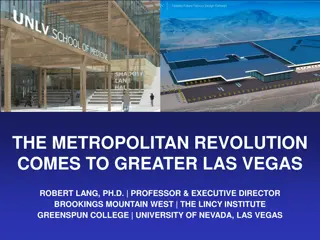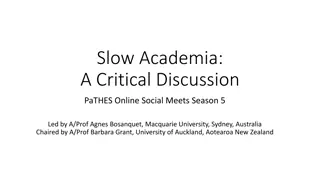The Slow Food Movement: A Revolution in Food Culture
The Slow Food Movement, initiated by Carlo Petrini in 1986, challenges the fast food industry and advocates for mindful consumption. Petrini's vision promotes awareness of food sourcing, support for sustainable practices, fair compensation for producers, and the enjoyment of nutritious, flavorsome foods shared in communal settings. This movement seeks to counter the negative impacts of fast food chains by revitalizing the connection between people, food, and the environment.
Download Presentation

Please find below an Image/Link to download the presentation.
The content on the website is provided AS IS for your information and personal use only. It may not be sold, licensed, or shared on other websites without obtaining consent from the author.If you encounter any issues during the download, it is possible that the publisher has removed the file from their server.
You are allowed to download the files provided on this website for personal or commercial use, subject to the condition that they are used lawfully. All files are the property of their respective owners.
The content on the website is provided AS IS for your information and personal use only. It may not be sold, licensed, or shared on other websites without obtaining consent from the author.
E N D
Presentation Transcript
When you really think about what you re eating it s scary.
Everyday people are putting this into their bodies.
THE SLOW FOOD MOVEMENT BEGAN Slow food is an international movement founded by Carlo Petrini in 1986. Italian journalist Carlo Petrini was so incensed in 1986 when a McDonald s outlet opened next to the Spanish Steps in Rome, an epicurean revolt was launched.
When a McDonalds was built on the Spanish Steps in Rome, it crossed a line with Petrini.
A fast food restaurant opening in the heart of Rome's historic centre was not something to be taken lightly. These chains disrupted the tradition of restaurants and caf s that worked within a local and regional network of farm to market to table.
Carlo Petrini chose to show that there is a better way - he started the slow food movement. His goal is to demonstrate that we have a choice when it comes to food and wine.
Eating together and drinking together at the end of the day is a kind of sign of friendship or communion, and when that doesn't exist, it's a sadder, less cohesive society. Carlo Petrini
The Slow Food Movement is based on the belief that people should: Become aware of how food is grown and manufactured Support companies that honour natural resources Appropriately compensate food producers Seek foods that both taste good and are nutritionally whole
The philosophy of the Slow Food Movement is good, clean, and fair food. The movement aims to save traditional foods that are becoming extinct, because of the increase in convenience food manufacturing and the industrialization of food production.
Is there a correlation between the Slow Food Movement and people s general concern about the loss of quality of life associated with rampant development that threatens the character of their community?
Slow Activism Slow food movement A tantalizing mix of politics, environmentalism and the pursuit of pleasure. -CBC The Slow Food Movement has led to:- Slow travel Slow cities Slow schools Slow living Slow money Slow books
Food For Thought.. From the Slow Food Manifesto We are enslaved by speed and have all succumbed to the same insidious virus: Fast Life, which disrupts our habits, pervades the privacy of our homes and forces us to eat Fast Foods. In the name of productivity, Fast Life has changed our way of being and threatens our environment and our landscapes. So Slow Food is now the only truly progressive answer.
SOME FOLLOW UP READING...... www.slowfood.com www.slowfoodaustralia.com.au http://www.slowmovement.com/slow_cities.php http://www.yogajournal.com/lifestyle/793 http://oss.sagepub.com/content/32/12/1717.full.pdf+html http://www.armstrong.edu/images/Good_Clean_Fair.pdf http://scholarworks.gsu.edu/cgi/viewcontent.cgi?article=1087&context=communication_theses Centers for Disease Control and Prevention. "U.S. Obesity Trends," www.cdc.gov. Kant, AK. Graubard, BI. Eating out in America, 1987-2000: trends and nutritional correlates," www.ncbi.nlm.nih.gov. National Restaurant Association. "National Restaurant Association 2011 Forecast," www.restaurant.org. The Journal of the American Medical Association. "Patterns and Trends in Food Portion Sizes, 1977-1998, . www.jama.amassn.org. http://ir.uiowa.edu/cgi/viewcontent.cgi?article=2695&context=etd























